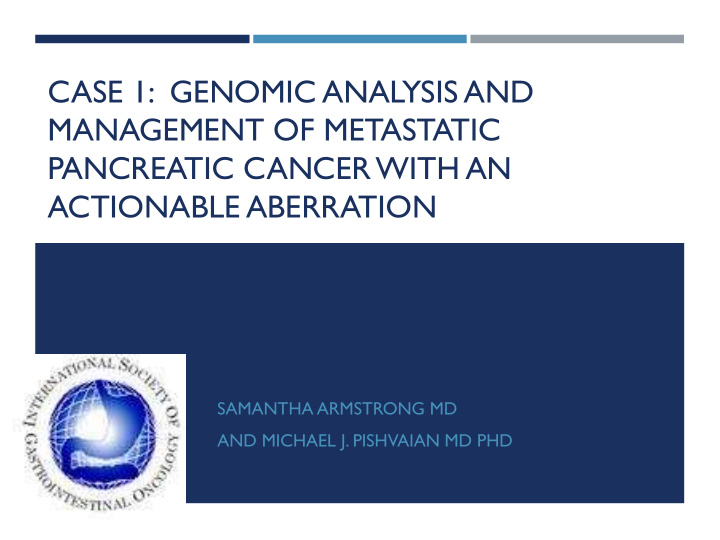



CASE 1: GENOMIC ANALYSIS AND MANAGEMENT OF METASTATIC PANCREATIC CANCER WITH AN ACTIONABLE ABERRATION SAMANTHA ARMSTRONG MD AND MICHAEL J. PISHVAIAN MD PHD
QUESTION #1: The percent of pancreatic cancers that harbor potentially “actionable” alterations (for which there is an FDA approved therapy [in pancreatic cancer OR other disease types]) is: 3 – 5% A. 10% B. C. 25% D. 40%
QUESTION #1: The percent of pancreatic cancers that harbor potentially “actionable” alterations (for which there is an FDA approved therapy [in pancreatic cancer OR other disease types]) is: 3 – 5% A. 10% B. C. 25% D. 40% Pishvaian, et al, Clinical Cancer Research, 2018; Heeke, et al, JCO Precision Oncology, 2018; Aguirre, et al, Cancer Discovery, 2018; Witkiewicz, et al, Nat Commun, 2015; Lowery, et al, Clinical Cancer Research, 2017; Waddell, et al, Nature, 2015; Bailey, et al, Nature, 2016; Biankin, et al, Nature, 2012; Collisson, et al, Nat Med, 2011
HISTORY OF PRESENT ILLNESS Previously healthy 51 year old female presented with abdominal pain in 2014 No medical or surgical history No tobacco or ETOH use Family history: father with lung cancer
DIAGNOSIS CT Scan (and a subsequent MRI/MRCP) showed a 2.9 x 2.6cm pancreatic head mass encasing the SMA EUS-FNA pathology: well- differentiated adenocarcinoma Diagnosis: locally advanced unresectable pancreatic adenocarcinoma Image From Uptodate.com I
TREATMENT TIMELINE Frontline FOLFOX 12/2014 - 10/2016 Held oxaliplatin after Cycle 6 for neuropathy Incorporated SBRT to the mass in 03/2015 October, 2016 restaging scan: large right ovarian tumor (12 x 10 x 12cm) Resected in 11/2016 – pathology consistent with a metastasis from the pancreatic primary Reinitiated FOLFOX 11/2016 Oxaliplatin stopped after only 4 additional cycles for an allergy
QUESTION #2: Is the presence of a germline BRCA1/2 mutation in pancreatic cancer know to be: Prognostic A. Predictive of a response to platinum-based therapy B. C. Both A and B D. Neither A nor B
QUESTION #2: Is the presence of a germline BRCA1/2 mutation in pancreatic cancer known to be: Prognostic A. B. Predictive of a response to platinum-based therapy C. Both A and B D. Neither A nor B Golan, et al, BJC, 2014; Pishvaian, et al, JCO PO, manuscript in press, 2019
MOLECULAR PROFILING OF THE METASTASIS BRCA1 & BRCA2 non-mutated ATM mutation in exon 25 p.L1238fs KRAS mutation in exon 2 p.Gt2D SMAD4 mutation in exon 10 p.V387fs MET mutation in exon 2 p.P164A MS-stable Total mutational burden: 10 mutations/Mb
QUESTION #3: The most common potentially “actionable” alteration in pancreatic cancer is a (an): KRAS mutation A. BRCA1 or -2 mutation B. ATM mutation C. D. Defect in mismatch repair (MMR deficient/MSI-high) NTRK fusion E.
QUESTION #3: The most common potentially “actionable” alteration in pancreatic cancer is a (an): KRAS mutation A. BRCA1 or -2 mutation B. C. ATM mutation – 6.2% across multiple publications D. Defect in mismatch repair (MMR deficient/MSI-high) NTRK fusion E. Pishvaian, et al, Clinical Cancer Research, 2018; Heeke, et al, JCO Precision Oncology, 2018; Aguirre, et al, Cancer Discovery, 2018; Witkiewicz, et al, Nat Commun, 2015; Lowery, et al, Clinical Cancer Research, 2017; Waddell, et al, Nature, 2015; Bailey, et al, Nature, 2016; Biankin, et al, Nature, 2012; Collisson, et al, Nat Med, 2011
TREATMENT TIMELINE - CONTINUED Transitioned to maintenance capecitabine 2/2017-6/2018 February, 2018 restaging scan: prepubic soft tissue mass (3.2 x 2.4 cm) Suprapubic metastasectomy 3/15/2018 May, 2018 restaging scan showed pulmonary metastatic disease
TREATMENT TIMELINE - CONTINUED Phase I trial of carboplatin plus niraparib 6/2018-8/2018 No benefit: August, 2018 restaging scan showed an enlarged cervix, and a pelvic exam revealed a 4 cm cervical lesion Radiation to the cervical metastasis 9/2018 Gemcitabine plus nab-paclitaxel 11/2018-1/2019 At progression enrolled in a Phase I trial of irinotecan, veliparib and the ATR inhibitor VX-970 Disease stable on trial through 6 months
IMPORTANCE OF GENOMIC SEQUENCING Identify therapeutically relevant alterations in ~25% of PDACs The majority of mutations identified are in the DNA damage response and repair (DDR) genes DDR mutations render cells more sensitive to DNA damage Classically BRCA1/2 mutations respond to platinums and PARPi But…..not all DDR mutations are the same Research needed to identify how to treat different mutations Pishvaian, et al, Clinical Cancer Research, 2018; Heeke, et al, JCO Precision Oncology, 2018; Aguirre, et al, Cancer Discovery, 2018; Witkiewicz, et al, Nat Commun, 2015; Lowery, et al, Clinical Cancer Research, 2017; Waddell, et al, Nature, 2015; Bailey, et al, Nature, 2016; Biankin, et al, Nature, 2012; Collisson, et al, Nat Med, 2011
ATM MUTATIONS IN PDAC ATM’s Function: ATM is one of the most commonly mutated DDR genes in PDAC Cell cycle checkpoint kinase Somatic mutations 2 - 18% Regulate downstream proteins Germline mutations 1 - 34% Respond to DNA damage for genome stability Armstrong et al, Manuscript in Press, Molecular Cancer Research
THERAPEUTIC SIGNIFICANCE OF ATM MUTATIONS Uniquely sensitive to radiation therapy As seen in this case - prolonged control with SBRT Unlike BRCA1/2 mutations, ATM mutations are not always responsive to platinum agents and PARP inhibitors As seen in this case - rapid progression on platinum + a PARPi Synthetic lethality with an ATR inhibitor in the context of an ATM mutation Armstrong et al, Manuscript in Press, Molecular Cancer Research; Blackford and Jackson, Molecular Cell 66, June 15, 2017
TAKE AWAY POINTS Genetic profiling is crucial in every pancreatic cancer patient Not all DDR mutations are the same, we still need to identify how to treat each mutation differently Promising preclinical data utilizing ATR inhibition +/- chemotherapy in ATM -mutated tumors
Recommend
More recommend